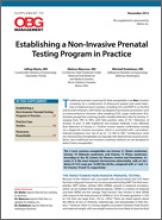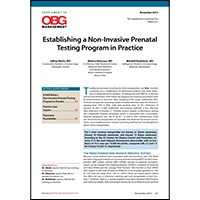User login
Establishing a Non-Invasive Prenatal Testing Program in Practice
Traditional prenatal screening for fetal aneuploidies involves screening via a combination of ultrasound analysis and serial detection of maternal serum markers, including hCG and PAPP-A, in the first and second trimesters, with follow-up diagnosis by invasive procedures such as amniocentesis or chorionic villus sampling (CVS). Large, multicenter, first-trimester prospective screening studies revealed detection rates for trisomy 21 ranging from 79% to 90%, with false positive rates of 5%.2 Detection of trisomy 18 and 13 with traditional non-invasive methods is less effective than detection of trisomy 21. Positive screens require confirmatory testing via a diagnostic invasive procedure, which is associated with a procedure-induced pregnancy loss risk of up to 1 in 300 to 500.3 Furthermore, most sex chromosome aneuploidies are typically only detected by invasive procedures, since traditional non-invasive screening methods are not designed to detect these aneuploidies.
Traditional prenatal screening for fetal aneuploidies involves screening via a combination of ultrasound analysis and serial detection of maternal serum markers, including hCG and PAPP-A, in the first and second trimesters, with follow-up diagnosis by invasive procedures such as amniocentesis or chorionic villus sampling (CVS). Large, multicenter, first-trimester prospective screening studies revealed detection rates for trisomy 21 ranging from 79% to 90%, with false positive rates of 5%.2 Detection of trisomy 18 and 13 with traditional non-invasive methods is less effective than detection of trisomy 21. Positive screens require confirmatory testing via a diagnostic invasive procedure, which is associated with a procedure-induced pregnancy loss risk of up to 1 in 300 to 500.3 Furthermore, most sex chromosome aneuploidies are typically only detected by invasive procedures, since traditional non-invasive screening methods are not designed to detect these aneuploidies.
Traditional prenatal screening for fetal aneuploidies involves screening via a combination of ultrasound analysis and serial detection of maternal serum markers, including hCG and PAPP-A, in the first and second trimesters, with follow-up diagnosis by invasive procedures such as amniocentesis or chorionic villus sampling (CVS). Large, multicenter, first-trimester prospective screening studies revealed detection rates for trisomy 21 ranging from 79% to 90%, with false positive rates of 5%.2 Detection of trisomy 18 and 13 with traditional non-invasive methods is less effective than detection of trisomy 21. Positive screens require confirmatory testing via a diagnostic invasive procedure, which is associated with a procedure-induced pregnancy loss risk of up to 1 in 300 to 500.3 Furthermore, most sex chromosome aneuploidies are typically only detected by invasive procedures, since traditional non-invasive screening methods are not designed to detect these aneuploidies.

